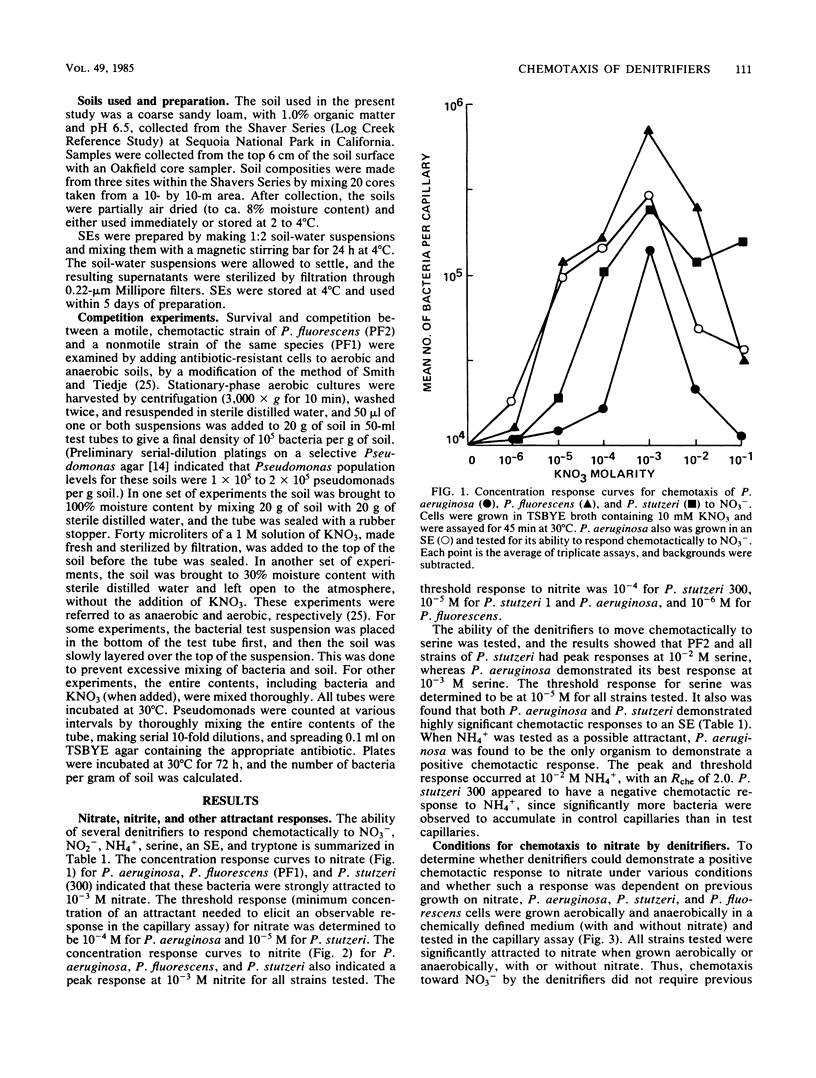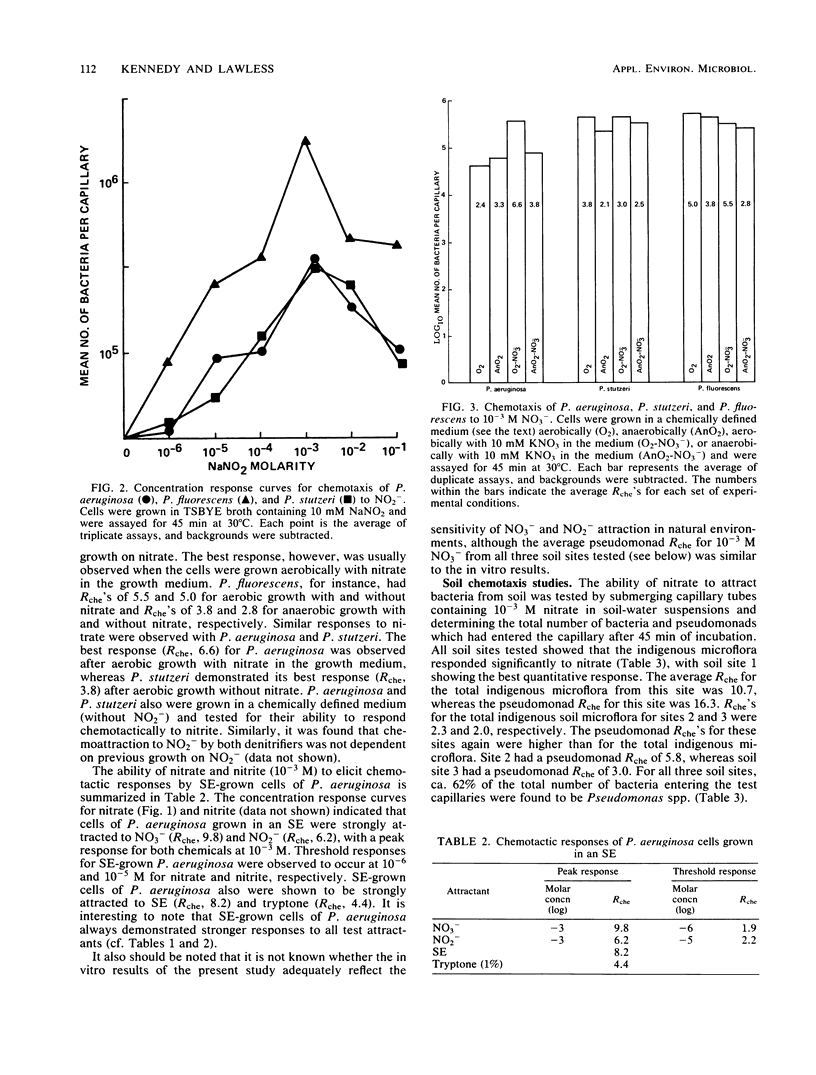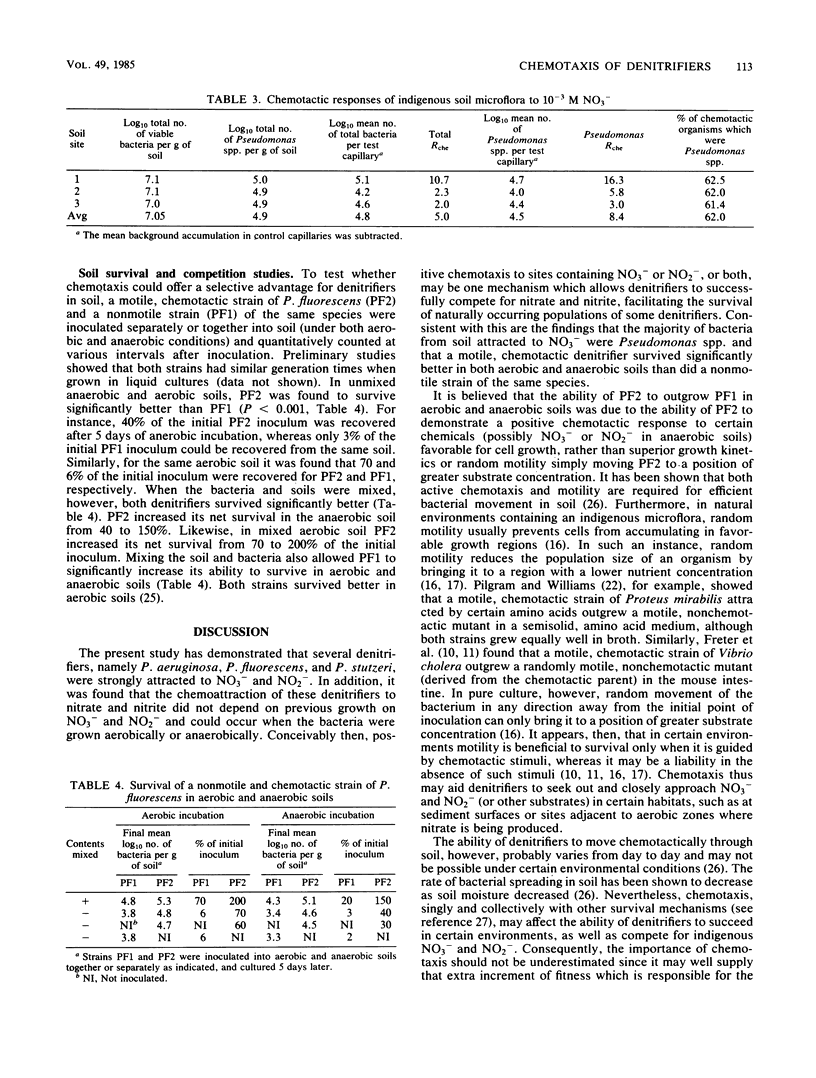Abstract
A modification of the Adler capillary assay was used to evaluate the chemotactic responses of several denitrifiers to nitrate and nitrite. Strong positive chemotaxis was observed to NO3− and NO2− by soil isolates of Pseudomonas aeruginosa, Pseudomonas fluorescens, and Pseudomonas stutzeri, with the peak response occurring at 10−3 M for both attractants. In addition, a strong chemoattraction to serine (peak response at 10−2 M), tryptone, and a soil extract, but not to NH4+, was observed for all denitrifiers tested. Chemotaxis was not dependent on a previous growth on NO3−, NO2−, or a soil extract, and the chemoattraction to NO3− occurred when the bacteria were grown aerobically or anaerobically. However, the best response to NO3− was usually observed when the cells were grown aerobically with 10 mM NO3− in the growth medium. Capillary tubes containing 10−3 M NO3− submerged into soil-water mixtures elicited a significant chemotactic response to NO3− by the indigenous soil microflora, the majority of which were Pseudomonas spp. A chemotactic strain of P. fluorescens also was shown to survive significantly better in aerobic and anaerobic soils than was a nonmotile strain of the same species. Both strains had equal growth rates in liquid cultures. Thus, chemotaxis may be one mechanism by which denitrifiers successfully compete for available NO3− and NO2−, and which may facilitate the survival of naturally occurring populations of some denitrifiers.
Full text
PDF





Selected References
These references are in PubMed. This may not be the complete list of references from this article.
- Adler J. A method for measuring chemotaxis and use of the method to determine optimum conditions for chemotaxis by Escherichia coli. J Gen Microbiol. 1973 Jan;74(1):77–91. doi: 10.1099/00221287-74-1-77. [DOI] [PubMed] [Google Scholar]
- Adler J. Chemotaxis in bacteria. Annu Rev Biochem. 1975;44:341–356. doi: 10.1146/annurev.bi.44.070175.002013. [DOI] [PubMed] [Google Scholar]
- Betlach M. R., Tiedje J. M. Kinetic explanation for accumulation of nitrite, nitric oxide, and nitrous oxide during bacterial denitrification. Appl Environ Microbiol. 1981 Dec;42(6):1074–1084. doi: 10.1128/aem.42.6.1074-1084.1981. [DOI] [PMC free article] [PubMed] [Google Scholar]
- Chet I., Mitchell R. Ecological aspects of microbial chemotactic behavior. Annu Rev Microbiol. 1976;30:221–239. doi: 10.1146/annurev.mi.30.100176.001253. [DOI] [PubMed] [Google Scholar]
- Currier W. W., Strobel G. A. Chemotaxis of Rhizobium spp. to Plant Root Exudates. Plant Physiol. 1976 May;57(5):820–823. doi: 10.1104/pp.57.5.820. [DOI] [PMC free article] [PubMed] [Google Scholar]
- Freter R., O'Brien P. C., Halstead S. A. Adhesion and chemotaxis as determinants of bacterial association with mucosal surfaces. Adv Exp Med Biol. 1978;107:429–437. doi: 10.1007/978-1-4684-3369-2_48. [DOI] [PubMed] [Google Scholar]
- Freter R., O'Brien P. C., Macsai M. S. Role of chemotaxis in the association of motile bacteria with intestinal mucosa: in vivo studies. Infect Immun. 1981 Oct;34(1):234–240. doi: 10.1128/iai.34.1.234-240.1981. [DOI] [PMC free article] [PubMed] [Google Scholar]
- Freter R., O'Brien P. C. Role of chemotaxis in the association of motile bacteria with intestinal mucosa: chemotactic responses of Vibrio cholerae and description of motile nonchemotactic mutants. Infect Immun. 1981 Oct;34(1):215–221. doi: 10.1128/iai.34.1.215-221.1981. [DOI] [PMC free article] [PubMed] [Google Scholar]
- Gallucci K. K., Paerl H. W. Pseudomonas aeruginosa Chemotaxis Associated with Blooms of N(2)-Fixing Blue-Green Algae (Cyanobacteria). Appl Environ Microbiol. 1983 Feb;45(2):557–562. doi: 10.1128/aem.45.2.557-562.1983. [DOI] [PMC free article] [PubMed] [Google Scholar]
- Gamble T. N., Betlach M. R., Tiedje J. M. Numerically dominant denitrifying bacteria from world soils. Appl Environ Microbiol. 1977 Apr;33(4):926–939. doi: 10.1128/aem.33.4.926-939.1977. [DOI] [PMC free article] [PubMed] [Google Scholar]
- Grant M. A., Holt J. G. Medium for the selective isolation of members of the genus Pseudomonas from natural habitats. Appl Environ Microbiol. 1977 May;33(5):1222–1224. doi: 10.1128/aem.33.5.1222-1224.1977. [DOI] [PMC free article] [PubMed] [Google Scholar]
- Lauffenburger D., Aris R., Keller K. Effects of cell motility and chemotaxis on microbial population growth. Biophys J. 1982 Dec;40(3):209–219. doi: 10.1016/S0006-3495(82)84476-7. [DOI] [PMC free article] [PubMed] [Google Scholar]
- Lynch W. H. Effect of temperature on Pseudomonas fluorescens chemotaxis. J Bacteriol. 1980 Jul;143(1):338–342. doi: 10.1128/jb.143.1.338-342.1980. [DOI] [PMC free article] [PubMed] [Google Scholar]
- Moulton R. C., Montie T. C. Chemotaxis by Pseudomonas aeruginosa. J Bacteriol. 1979 Jan;137(1):274–280. doi: 10.1128/jb.137.1.274-280.1979. [DOI] [PMC free article] [PubMed] [Google Scholar]
- Payne W. J. Reduction of nitrogenous oxides by microorganisms. Bacteriol Rev. 1973 Dec;37(4):409–452. doi: 10.1128/br.37.4.409-452.1973. [DOI] [PMC free article] [PubMed] [Google Scholar]
- Pilgram W. K., Williams F. D. Survival value of chemotaxis in mixed cultures. Can J Microbiol. 1976 Dec;22(12):1771–1773. doi: 10.1139/m76-262. [DOI] [PubMed] [Google Scholar]
- Sjoblad R. D., Mitchell R. Chemotactic responses of Vibrio alginolyticus to algal extracellular products. Can J Microbiol. 1979 Sep;25(9):964–967. doi: 10.1139/m79-147. [DOI] [PubMed] [Google Scholar]
- Soby S., Bergman K. Motility and Chemotaxis of Rhizobium meliloti in Soil. Appl Environ Microbiol. 1983 Nov;46(5):995–998. doi: 10.1128/aem.46.5.995-998.1983. [DOI] [PMC free article] [PubMed] [Google Scholar]
- Tiedje J. M., Sexstone A. J., Myrold D. D., Robinson J. A. Denitrification: ecological niches, competition and survival. Antonie Van Leeuwenhoek. 1982;48(6):569–583. doi: 10.1007/BF00399542. [DOI] [PubMed] [Google Scholar]


